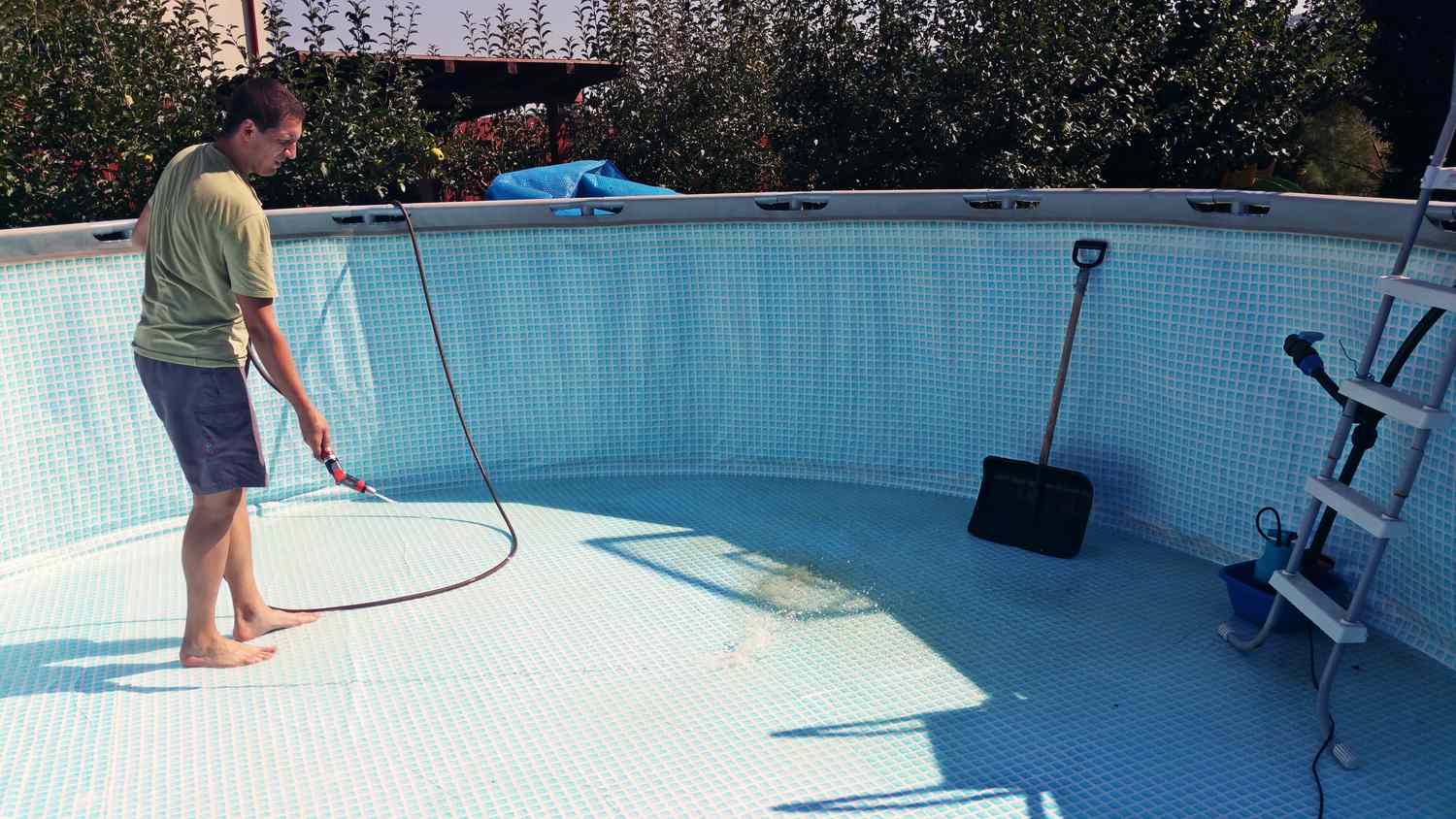Picture this: you've just had your pool plastered and are excited to dive into its rejuvenated waters. But before you reach for the thermostat, it's crucial to understand the appropriate timing for heating your pool.
In this informative article, we will discuss why immediate heating should be avoided after pool plastering. We will also provide aftercare tips for new pool plaster, as well as offer dos and don'ts for efficient pool heating.
Whether you're a pool owner or a professional in the industry, this article will equip you with valuable insights and guidance.
Key Takeaways
- Do not heat your pool for approximately a month after plastering.
- Heating too soon can damage the heating equipment and plaster.
- The first two weeks after filling the pool are crucial for the curing process.
- Avoid using the heater at all for the first 28 days if possible.
Curing Process for Newly Plastered Pools
The curing process for newly plastered pools is an essential phase in ensuring the longevity and durability of the pool's surface. Pool plaster curing refers to the chemical reaction that takes place between water and cement, resulting in the hardening and strengthening of the plaster. This process is crucial as it helps to prevent cracks, surface deterioration, and other potential issues that can arise from improper curing.
During the curing process, it is important to provide optimal conditions for the plaster to set and cure properly. This includes maintaining proper water chemistry and temperature, as well as ensuring adequate circulation and filtration. It is recommended to run the filtration system for at least 72 hours after filling the pool to remove any impurities and promote proper curing.
Additionally, it is crucial to avoid heating the pool too soon after plastering. Heating the pool before the plaster has fully cured can lead to cracks and other damage to the surface. It is generally recommended to wait for at least a month before heating the pool to allow sufficient time for the plaster to cure properly.
Importance of Balancing Water Chemistry
Balancing water chemistry is of utmost importance for maintaining the health and cleanliness of your pool.
Properly balanced water prevents the growth of algae, bacteria, and other contaminants that can affect the clarity and safety of your pool.
Water Chemistry Importance
Properly balancing water chemistry is crucial for maintaining the integrity and longevity of your pool after plastering. The importance of balancing water chemistry cannot be overstated, as it has a direct impact on the health and safety of swimmers, as well as the overall condition of your pool.
When the water chemistry is balanced, it helps prevent the growth of harmful bacteria, algae, and other contaminants. It also helps to protect the plaster from damage, such as etching or staining.
Balancing water chemistry involves monitoring and adjusting the pH level, alkalinity, calcium hardness, and sanitizer levels. Regular testing and maintenance of water chemistry are essential to ensure a clean and safe swimming environment.
Balancing for Pool Health
When should you begin balancing water chemistry for optimal pool health after plastering?
It is crucial to start balancing water chemistry immediately after the pool renovation to ensure the longevity and health of your pool. Proper water chemistry is essential for maintaining clear, safe, and comfortable swimming conditions.
Here are three reasons why balancing water chemistry is of utmost importance:
- Prevents algae growth: Balanced water chemistry helps prevent the growth of algae, which can turn your pool into a green and unsightly mess. Algae growth can also make the pool slippery and pose a safety hazard.
- Protects equipment: Unbalanced water chemistry can cause corrosion and damage to pool equipment, including pumps, filters, and heaters. By balancing the water chemistry, you can extend the lifespan of your equipment and avoid costly repairs or replacements.
- Promotes swimmer comfort: Balanced water chemistry ensures that the pool is gentle on the skin, eyes, and hair. It prevents skin irritation, red eyes, and dry hair, providing a comfortable swimming experience for you and your guests.
Potential Damage From Immediate Heating
Immediate heating of a newly plastered pool can lead to potential damage to both the heating equipment and the plaster itself. Heating too soon can cause plaster expansion and result in cracks, compromising the durability and longevity of the pool surface.
It is important to exercise patience and allow the plaster to cure properly before introducing heat to ensure the integrity of the pool.
Heating Equipment and Plaster
Heating your pool immediately after plastering can potentially cause damage to both the heating equipment and the plaster. It is crucial to allow the plaster to cure and balance the water chemistry for the first two weeks after filling the pool. Here are three reasons why immediate heating should be avoided:
- Newly plastered walls shed plaster dust for a few weeks, which can clog heater tubes and damage equipment.
- Heating before adequate curing can lead to plaster expansion and cracks.
- Patience is necessary to protect the investment in plaster and heating equipment, ensuring a longer lifespan for the plaster.
To protect your pool and heating equipment, it is recommended to delay heating for at least 28 days if possible. This will allow the plaster to fully cure and minimize the risk of damage. Consider using alternative pool heating options, such as solar covers or liquid solar covers, to save energy and avoid potential damage.
Plaster Expansion and Cracks
During the curing process, the risk of plaster expansion and subsequent cracks is heightened if the pool is heated too soon after plastering. It is important to understand that plaster undergoes a chemical reaction during curing, which can cause it to expand. If the pool is heated immediately after plastering, this expansion can put stress on the plaster, potentially leading to cracks.
These cracks not only compromise the aesthetic appearance of the pool but also create an opportunity for water to infiltrate the plaster, causing further damage. To avoid such issues, it is recommended to wait at least a month before heating the pool after plastering. This allows ample time for the plaster to fully cure and minimize the risk of plaster expansion and cracks.
Now, let's move on to discuss some aftercare tips for new pool plaster.
Aftercare Tips for New Pool Plaster
After plastering your pool, it is important to focus on the aftercare to ensure the longevity and durability of the new pool plaster. Proper aftercare will not only protect your investment but also maintain the beauty and functionality of your pool.
Here are some essential aftercare tips for new pool plaster:
- Brush the pool twice a day: Use a nylon brush to gently brush the pool walls and floor for the first 2-3 weeks. This helps to remove any loose plaster particles and promote even curing.
- Run the filtration system: After filling the pool, run the filtration system continuously for 72 hours. This will help to remove any debris or impurities and keep the water clean.
- Dilute chemicals before adding: When adding chemicals to the pool, dilute them in a five-gallon bucket of water before pouring them in. This prevents direct contact with the plaster and reduces the risk of staining or damage.
Following these aftercare tips will ensure that your new pool plaster cures properly and remains in excellent condition for years to come.
It is crucial to be patient during the initial stages and avoid using automated cleaning systems or shocking the pool during the first month. By taking these precautions, you can enjoy a beautiful and long-lasting pool plaster that enhances your swimming experience.
Dos and Don'ts for Heating Your Pool
To ensure optimal heating efficiency and protect your pool equipment, it is important to follow these dos and don'ts when it comes to heating your pool after plastering. Following these pool heating guidelines will help you avoid potential issues and prolong the lifespan of your pool and heating system.
Dos:
- Cover your pool when not in use: This will help keep the water clean and warm, reducing heat loss and saving energy.
- Consider using a solar cover or liquid solar cover: These options can further enhance energy efficiency by trapping heat and preventing evaporation.
- Regularly maintain your pool heater: Schedule regular inspections and cleanings to prevent malfunctions and ensure optimal performance.
- Block wind: Install solid fence enclosures or wind barriers to reduce wind exposure and evaporation, thereby saving on heating costs.
Don'ts:
- Heat your pool too soon after plastering: Waiting at least a month allows the plaster to properly cure and prevents damage to both the plaster and heating equipment.
- Neglect pool heater maintenance: Regular upkeep is essential to prevent costly repairs and maintain energy efficiency.
- Use automated cleaning systems or vacuum cleaners with wheels: These can potentially damage the pool surface, including the newly plastered area.
- Shock the pool during the first month of usage: Chemical shocks can disrupt the delicate balance of the water chemistry, affecting the curing process of the plaster.
Frequently Asked Questions About Pool Plastering and Heating
One common question that arises regarding pool plastering and heating is the recommended time frame for heating your pool after plastering. It is crucial to exercise patience and allow the plaster to properly cure before heating the pool. Here are some frequently asked questions about pool plastering and heating:
- How long should I wait before heating my pool after plastering?
- It is recommended to wait at least a month after plastering before heating your pool. This allows the plaster to cure and ensures that the heating equipment and plaster are not damaged.
- Why should I avoid immediate heating after plastering?
- Newly plastered walls shed plaster dust for a few weeks, which can clog heater tubes and damage equipment. Heating before adequate curing can also cause plaster expansion and cracks. Taking the time to let the plaster properly cure will protect your investment in both the plaster and the pool heating system.
- What are some additional tips for new pool plaster aftercare?
- Brush the pool twice a day for the first 2-3 weeks using a nylon brush to remove any loose plaster dust. Run the filtration system for 72 hours after filling the pool to help clear out any debris. Dilute chemicals in a five-gallon bucket before adding them to the pool to prevent any direct contact with the plaster. Avoid using automated cleaning systems or vacuum cleaners with wheels that may scratch the plaster. Lastly, avoid shocking the pool during the first month of usage to prevent any damage to the newly plastered surface.
Frequently Asked Questions
How Long Should You Wait Before Heating Your Pool After Plastering?
To ensure the longevity of your pool plaster and heating equipment, it is recommended to wait approximately a month before heating your pool after plastering. This allows for proper curing of the plaster and balancing of water chemistry. Heating too soon can lead to damage to the plaster and heating equipment.
During this period, it is essential to brush the pool daily, run the filtration system, and avoid using automated cleaning systems or vacuum cleaners with wheels.
Following these guidelines will protect your investment and promote a longer lifespan for your pool plaster.
What Can Happen if You Heat Your Pool Too Soon After Plastering?
Heating your pool too soon after plastering can have detrimental effects on both your heating equipment and the newly plastered walls. Immediate heating can lead to plaster expansion and cracks, as well as damage to the heating equipment due to the shedding of plaster dust.
It is crucial to allow the plaster to cure for approximately a month before considering heating the pool. Patience and proper care during the initial curing period will ensure a longer lifespan for the plaster and protect your investment in the heating equipment.
How Often Should You Brush the Pool During the First Few Weeks After Plastering?
During the first few weeks after plastering, it is important to regularly brush the pool to aid in the curing process.
Brushing the pool twice a day using a nylon brush helps to remove any loose plaster dust and ensures proper adhesion of the plaster.
This step is crucial in maintaining the integrity and longevity of the newly plastered pool.
Can You Use Automated Cleaning Systems or Vacuum Cleaners With Wheels on a Newly Plastered Pool?
Using automated cleaning systems or vacuum cleaners with wheels on a newly plastered pool is not recommended. The plaster needs time to cure and settle properly, and the use of such equipment can potentially damage or scratch the delicate surface.
It is best to avoid using automated cleaning systems or vacuum cleaners with wheels during the initial curing period to ensure the longevity and integrity of the newly plastered pool. Instead, manual brushing and regular maintenance are recommended for pool care during this time.
How Long Does It Typically Take to Heat a Pool After Plastering, and What Factors Can Affect the Heating Time?
The typical time to heat a pool after plastering can vary depending on several factors. The curing process of the plaster is crucial and should be given at least a month before heating to prevent damage to the equipment and plaster.
Factors such as the size of the pool, the heating method used, and the ambient temperature can also affect the heating time. Patience and proper care during the curing process will ensure the longevity of the plaster and optimal heating results.





